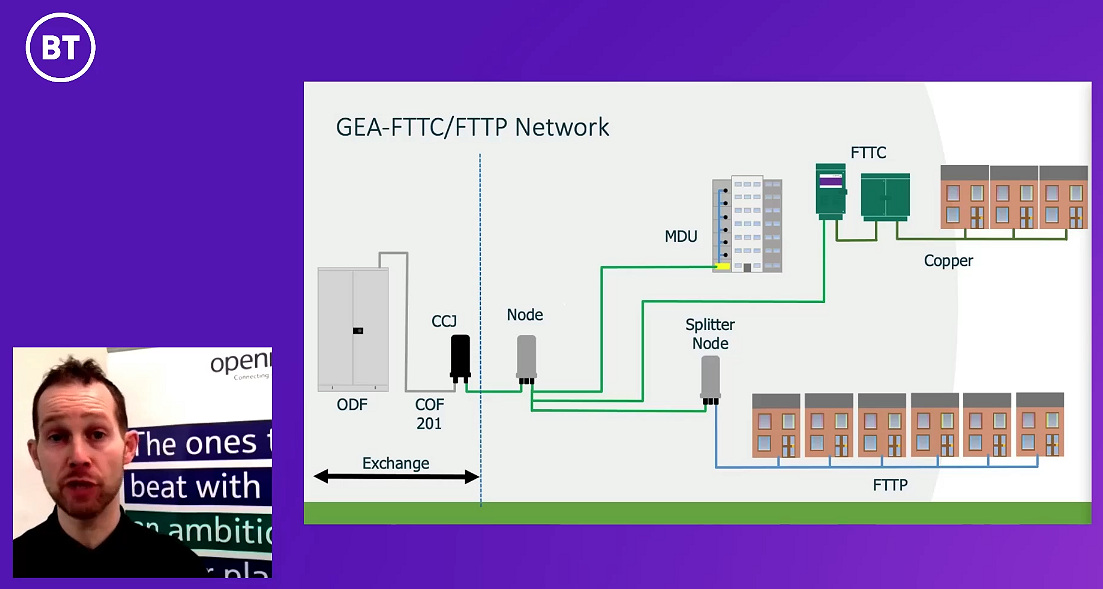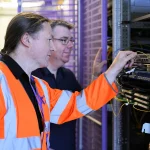VIDEO – Virtual Tour of FTTP Broadband with BT and Openreach

Openreach and BT (BTWholesale) have posted a useful and highly informative new video that cuts out the usual cosmetics in order to offer watchers an engineer’s eye-view style tour of how their new gigabit-capable UK Fibre-to-the-Premises (FTTP) broadband network is delivered – all the way from the exchange to the home.
Often videos like this will be all flash and little substance, but on this occasion Openreach appears to have asked their Regional Learning Manager in Bradford, Dominic Bottomley, to conduct somewhat of an unscripted overview of their network at one of the operator’s training facilities.
The video shows you everything from the exchange (headend / ODF) to aggregation nodes, splitters, Connectorised Block Terminals (CBT) and then all the way to in-home Optical Network Terminal (ONT / ONU). Overall, it’s significantly more informative than most of the videos out there and well worth a watch if you want to understand how FTTP works on Openreach’s platform.
Advertisement
The video itself is about 1 hour long, although the actual engineer’s segment only runs for roughly half of that time (you can happily skip the first 3:06 minutes of the introduction as that’s mostly just the usual PR spin).

As much of the video is indoors, seemingly inside a large warehouse, then there is a fair bit of background echo at times, which becomes fairly irritating after a period of watching (sadly they didn’t use an audio setup to cancel out the echo). At the end of the demo there’s also a Q&A segment, but you don’t need to watch that part.
The video was actually posted a couple of months ago, but it somewhat flew under our radar until one of ISPreview’s readers (Credits to Ross) spotted it hiding on Vimeo.
Advertisement
Mark is a professional technology writer, IT consultant and computer engineer from Dorset (England), he also founded ISPreview in 1999 and enjoys analysing the latest telecoms and broadband developments. Find me on X (Twitter), Mastodon, Facebook, BlueSky, Threads.net and Linkedin.
« IX Wireless and 6G Internet Launch Blackburn’s New Gigabit Network UPDATE
Opensignal Compares 5G Mobile Speeds Across UK and EMEA »






















































Watch it while you can, something tells me it won’t be there for much longer
i just downloaded it onto my computer so if its ever taken down i’ll just reupload it onto youtube
Looks useful – archived in case it goes the same way as the Virgin Media videos.
I knew it would happen so I saved the links to the videos. I will copy them in.
HFC network: https://youtu.be/IXHvS4SN1Ho
FTTP https://youtu.be/vwTMqn5-rKY
Head end tour https://youtu.be/GePWqhe5Vzo
Why were the VM videos removed?
@Ben Richardson – they claimed they were internal videos used solely for training purposes and accidentally set to public on YouTube.
Thanks, confirms the subsidised spines support all services.
another 2 = 2 = 8 then — almost as crazy as you comments on PIA yesterday
1 fibre path, multiple services possible. That’s what the Openreach video says. Spines to nodes and to splitters – multiple services can be configured.
On PIA, – well 25m commitment means OR will need to put fibre on every pole (DP), as OR only have a system size of 24.8m working lines. Space will be limited and it will be a race.
It is crazy in a good way, but it is more crazy spending years holding Openreach back, pretending complexity and costs well in excess of the actuality, allowing competitors including ex BT directors to raise funds and compete against the company they were meant to serve.
1 fibre path, multiple services possible. That’s what the Openreach video says. Spines to nodes and to splitters – multiple services can be configured.
can be configured, depending on where the nodes and spitters are in relation to the network and hwere the headend is for what you are trying to connect (you will note the FTTC and the FTTP part of the diagrams are not linked
what on earth are you on about fibre on every pole to meat the 25m who says Openreach will needs to do that – another piece of disinformation / made up / uninformed
so its fine for Zzoom , Gigaclear, county to build networks dont hear any complaints about them from you – you trumpet those constantly you only complain that an ex BT director is building a network
Fastman IMHO Gigaclear/County are bit players. It is of concern that someone from BT would wish to compare themselves to start ups. Gigaclear /County/Zoom will be flattered but will not kid themselves.
What else does a commitment of 25m premises mean? How else do you plan to deliver FTTP by 2026? The commitment translates to delivering fibre to ~13,000 poles a month every month until 2026.
On FTTC/FTTP co-existence! Are you suggesting FTTP does not use the same path/elements as FTTC when FTTP extends beyond the splitter feeding FTTC? FTTC will prove useful as means of tempering demand and permit FTTP build to continue into the 2040’s as demand arises.
I am not going to into this beyond to point out that ‘system size’ of xx million active lines makes no sense in the context of an FTTP rollout.
Openreach don’t have 100% of all the premises their network passes connected. Virgin Media and others take business from them.
To pass 25 million premises with FTTP doesn’t mean passing every premises with a currently active Openreach service. That would mean 100% coverage which they have not committed to.
Openreach pass nearly 100% of UK premises outside of Hull. They can reach the 25 million premises passed without anywhere near 100% of pole or duct coverage.
As a general rule a single property at the end of a long series of poles shared with no-one isn’t going to be a good commercial case for anyone.
Virgin Media pass 52% of UK premises and achieve 30-40% penetration.
This term ‘system size’ isn’t even especially useful in terms of premises passed. 20%-ish of premises Openreach pass don’t have active access lines, others will have multiple. A data centre may have tons of active Openreach lines but a single premises passed. A housing estate with Virgin Media and ADSL at 1 Mbit hundreds of premises passed, a handful of lines active.
@CarlT Of course, but what’s cheap for BT to do and defend? You have argued that rural can be cheaper/quicker than urban and there remains 00’s of millions stuck in BT’s accounts. £37m more added to the deferral this last quarter, with more than 480k under contract and yet to be delivered.
The point I was failing to make is that the distance between node and DP is not that great and so populating poles will be a quick and substantial means of making a lot of progress quickly, although at 4m DP poles it is ~13k a week, which may be asking too much and the clock is ticking.
I don’t care what’s in BT’s accounts. Any interest I had in the BDUK programme was lost about 175,000 of your posts on the matter ago.
Whether a home has active lines from Openreach or not is irrelevant to the deployment cost as fibre to the premises isn’t deployed to the property until ordered. Only the infrastructure to deliver matters.
It is massively more profitable to either protect existing clients from alternative networks or to try and win them back from them.
This is common sense. The minimal uplift in revenue on existing customers versus new ones is obvious and is a well rehearsed discussion.
The only comment I made was that your conflating ‘system size’ with premises passed was wrong. That’s it.
However: you’re also wrong on poles and nodes and I’m not sure why you’re suddenly fixated on poles. Ask some of the people on Think Broadband about the FTTPoD quotes they received and their distance from the aggregation nodes.
When my old property received FTTP a new node had been built. If you’re really interested it’s TPOCQ UNIVERSAL NODE 1A JBF 106 4434 O/S 4 TWENTYMAN WALK.
I’m not sure why you think populating poles will be such a rapid solution when many of them are duct fed, so there’s still the issue of getting fibre to them to begin with.
You seem to think that the aggregation nodes have fibre run from them to the poles and the job is done. They don’t. The ANs aggregate multiple PONs but are part of spine, there is a huge amount to do before the CBT, universal nodes like the above being part of that. These components don’t go on poles.
Regarding poles this isn’t some case of Openreach saying ‘bagses’ and again your implying they are going to be covering every single pole is simply wrong. They can get to 80-90% without going anywhere near every DP, be it on a pole or underground, and the business case runs dry before then for everyone bar B4RNs and publicly subsidised networks.
‘System size’ is not a measure of coverage. It’s not even a measure of size of a system as it ignores parts of the system because they aren’t being paid for at the time. Please stop using the term in this context it’s meaningless.
Premises passed is the only relevant metric to conversion of those premises passed by copper to fibre.
With that I am done here. The comments about BT’s accounts don’t interest me, the rest is either stating the blindingly obvious or wrong, despite my earlier explaining why some of it was wrong.
It’s not a warehouse, it’s in one of their many ‘Openstreet’ training facilities
I watch until I see the marked ‘Made In China’ I was wondering China could be spying on UK FTTP? Similiar to Huawei banned in UK!
Perhaps everything should be made in Telford then?
and how is “China” going to spy using passive equipment, which they don’t install or operate? Commscope are an American company FYI – a household name for this stuff.
Certainly an argument to be made over whether companies should continue to manufacture in China, but that’s not going to change overnight.
You know who makes the Huawei G.fast modem, which you had connected to your Huawei G.fast pod, which in turn connects to a Huawei OLT, and where they were made, right?
You know that TP-Link, makers of the VR2600 you were using, are based in Shenzen, China, right?
Potentially bad news on your Zyxel kit, too. Zyxel are based in Taiwan but I would check where the router itself was made as at least some of their kit is made in China.
Either way if you’re using Openreach whatever you buy your DSLAM and OLT are Huawei. You’d need to move to another area with Nokia kit to avoid Huawei.
Ivor, I don’t trust China anymore. They are cheap, dirty and spying!
I recall arriving in the Far East 15 years ago and thinking not long afterwards ‘but I was told by the media outlets in the West that these people lived in shacks and worked in the fields’. That visit certainly changed my perception of Asia generally as a modern market leader. The simple fact is, China on its own is a far bigger market than the USA, Russia, EU combined. And they are increasing that technology gap at a very rapid rate. Trains / EV / solar energy etc.
As for spying :-), at least in China they are very open about it to their citizens. Not like here in the UK where such things just happen without you or I even having a say in the matter. Fact is Google and the likes spy on you and know far more about you (and I) than we really would like them to know. And they are private companies, let alone the state.
America are the biggest spies going!!! They monitor the whole world’s communications, so why pick on china.
Because of Covid probably, good enough reason.
“The superfast broadband (we all know and love)” Full credit to Dom, he almost kept a straight face saying that.
If no pole, and no existing conduited copper into the premises OR are still going to need to dig-up someones front garden/patio/drive – that’s a significant addition to costs.
Whereas a 3 x radio device incorporating a DEM MUX communicating with a radio box on the outside of each house, with the addition of an extra power cable (For the radio demuxer) in the optic trench could eliminate all that labour and reduce the number of optic fibres that need to be run from the exchange.
ORs solution seems to be the worst of all Worlds, maximising the work necessary to make an end user connection and thereby increasing the costs and orogramme duration
I meant to say thats 3 x radio device per 100 house suburban street, each device having a broadcast diameter of 100 meters
There are many theoretical solutions that can be applied. G.Fast using the last 100 metres of the copper, WIFI, Facebook’s Terragraph, mini 5G masts etc. The common theme though is powered equipment and who/how should they be powered (Street supply, CPE or Solar). Only VM as a main provider appear to be using powered equipment (locally to the customer) in their FTTP strategy.
Running FTTP to existing poles appears to be the current favourite whether OR, CityFibre or FW. You can cover multiple premises with less effort and without worrying about which ones or how many will actually take up the service. But people don’t like poles and many were rather hoping they would disappear. Certainly those proposing new ones have had to rethink https://www.bbc.co.uk/news/uk-england-tyne-57116846
OR thankfully has duct to a good percentage of premises so its more likely that Altnets will be the ones digging up paths/drives/gardens but this can be minimised if their subcontractors place the toby box correctly on the property boundary. Unfortunately I have recently seen them placed in line with the front door straight across recently laid block or resin driveways which will make the installation a little more challenging.
Despite OR PIA access CityFibre appear to be ducting all the way from their aggregation points to the customer where it is UG.
An issue may be where OR cabling is directly buried and whether they will retrospectively install duct or simply leave it for now to an Altnet or VM in those areas. This will probably depend on their surrounding coverage and plans in the area.
As shown by the video OR’s current focus is to cover as many premises in a coordinated rollout as possible while minimising complexity. Things may change later but I am sure all technologies current and future are constantly reviewed.
Smaller Altnets are more likely to be more innovative e.g Hyperoptics WIFI.
Why would the number of fibres from the exchange be reduced? You know that in an xPON model the fibre is shared between multiple customers? It’s not one per home.
I loved the Video
So that is what we can expect around here then (about eighteen months after hell freezes over) …
Brilliant video, really informative, thank you to all who made this possible.
Great video, thanks for sharing.
Once the fibre is flown pole to premises, that’s it, the poles are there for good, even when copper’s pulled.
Amongst the catalogue of small scale civil enginerring kit there must be worm drills, that can trail a cable behind then and which only generate a single small entry point into and exit from the subsoil, avoiding the necessity to dig-up gardens and drives.
That used in conjunction with contractors existing ground radar . . .
Changing topic slightly, reference the film, I wonder how long those plastic trays/blades in the OR exchanges will last in normal use ?
>> I wonder how long those plastic trays/blades in the OR exchanges will last in normal use ?
A very long time I would expect – once everything is installed and connected it would be a very rare occurrence to actually open one of the trays.
Does anyone know how long it takes after the the equipment is installed on the poles to FTTP service being available to the customers in that area? In my area, I’ve seen BT Openreach doing the installations recently, but FTTP is not yet available yet.
A great and well done talk on latest technology
Also wonder why those blades/trays in the OR exchanges are not coloured black. In the event degradation of the fibre covering over time, escaping light will get reflected everywhere making the serviceable/unserviceable gradient if the kit very sharp!.
JAT.
What? I’ve worked with fibres for 35 years. What you describe has never happened, ever. What degradation do you think is going to happen? Do you understand the term ‘Total Internal Reflection’? It’s not the cable sheath that prevents light escaping,
I hope someone explains to him how to say premises.
Thanks to Ross for sharing this. No fibre around here yet but hopefully Project Gigabit will deliver eventually, but watched this to see what technology they would use on the poles, and actually endured the Q&A.
So what speed could they deliver? One of the Q&A answers indicated that all the current deployments use 32 way splitters. As I understand it the PON delivers 2.5Gbps in total and that presumably has some framing and encryption on top of it so the actual payloads will be less. If that gets split 32 ways that is less than 100Mbps to each node – isn’t that a problem with most ISPs offering 100-150Mbps packages, especially if you get a few 900Mbps users?